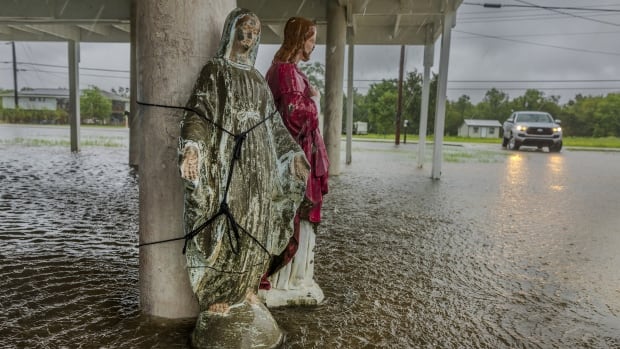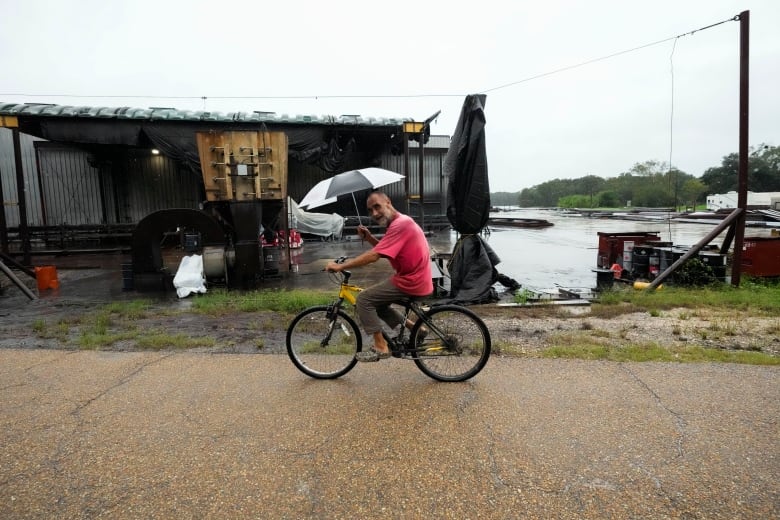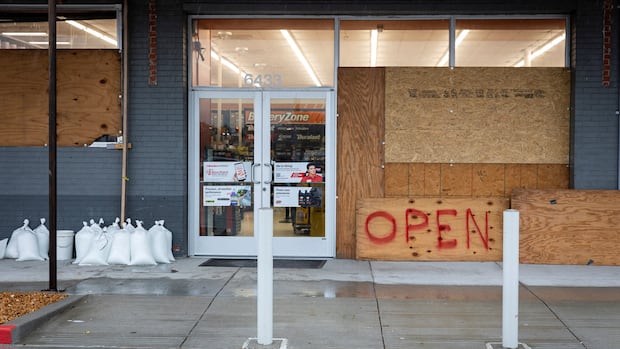
Hurricane Francine made landfall Wednesday in Louisiana as a Category 2 storm, bringing powerful winds, storm surge and potential flooding to the northern U.S. Gulf Coast.
Having drawn fuel from exceedingly warm Gulf of Mexico waters, Francine had maximum sustained winds of 161 km/h when it roared ashore in Terrebonne Parish, the Miami-based National Hurricane Center (NHC) said — hitting a coastline that has yet to fully recover from a series of devastating hurricanes in 2020 and 2021.
Parts of Mississippi, Alabama and the Florida Panhandle were at risk of flooding. The lower Mississippi Valley and lower Tennessee Valley could see flooding later in the week as the storm sweeps inland.
In Morgan City, La., gas stations had put plywood on the windows and moved trash cans inside before the storm hit, with a few pumps still serving the trickle of cars passing through shortly after dawn.
Larry Doiron, the owner of a Chevron station just outside the city limits, said he had enough gas to keep pumps operational through the storm.
“We’re the only place out here for the sheriff’s department, the fire department. We have gas. All the locals depend on us,” he said. “We’re going to try and stay on top of it and hopefully take care of everybody.”
The community of some 11,500 people, 115 kilometres southwest of New Orleans, is surrounded by lakes and marsh. By Wednesday evening the storm was about 105 kilometres to its southwest, heading in its general direction at 27 km/h, according to the NHC.
‘The time to evacuate has now passed,’ a top emergency official in Louisiana said Wednesday as Hurricane Francine neared. People who were still in the path were urged to stay put and be cautious.
Retired boat captain Pat Simon, 75, and his wife, Ruth, loaded all their possessions in garbage bags and tied them down in the back of a rented U-Haul pickup truck as they evacuated their home near the banks of the nearby Atchafalaya River.
“I don’t think it’s going to be that bad, like some of the other ones like Ida and Katrina,” Pat Simon said. “I mean, we’ve had some bad ones.”
Louisiana Gov. Jeff Landry urged residents to “stay off the roads, stay home and stay put.”
“I know that we have been through a lot here in Louisiana, but I urge everyone to take the necessary preparations,” he said.

Hurricane season typically peaks around this time of year and Louisiana residents have often faced threats from such storms. Since the mid-19th century 57 hurricanes have tracked over or made landfall in Louisiana, according to The Weather Channel. Among them were some of the strongest, costliest and deadliest storms in U.S. history.
Landry said the Louisiana National Guard was being sent to parishes that could be impacted by Francine. They have food, water, nearly 400 high-water vehicles, about 100 boats and 50 helicopters to respond to the storm, including possible search-and-rescue operations.
Biden declares emergency
U.S. President Joe Biden granted an emergency declaration that will help Louisiana secure federal money and logistical assistance from partners such as the Federal Emergency Management Agency. Both Landry and Mississippi Gov. Tate Reeves also declared states of emergency, authorizing them to quickly free up resources for disaster assistance.
A hurricane warning was in effect along the Louisiana coast from Cameron east to Grand Isle, about 80 kilometres south of New Orleans, according to the NHC. A storm surge warning stretched from the Mississippi-Alabama border to the Alabama-Florida border. Such a warning means life-threatening flooding could occur.
The Mississippi Emergency Management Agency said it distributed more than 100,000 sandbags to the southern part of the state and the Department of Education reported a number of school district closures for Wednesday and Thursday.
Bands of heavy rain were hitting New Orleans Wednesday morning. The city’s historic streetcars that roll on South Carrollton Avenue had to ease past cars parked next to the tracks on the grassy median. The median is a few inches higher than the street and drivers sometimes park there to avoid street flooding.
Francine is the sixth named storm of the Atlantic hurricane season. Much of Louisiana and Mississippi could get 10 to 20 centimetres of rain, with the possibility of 30 centimetres in some spots said Brad Reinhart, a senior hurricane specialist at the NHC.
Francine’s storm surge on the Louisiana coast could reach as much as three metres from Cameron to Port Fourchon and into Vermilion Bay, forecasters said.
